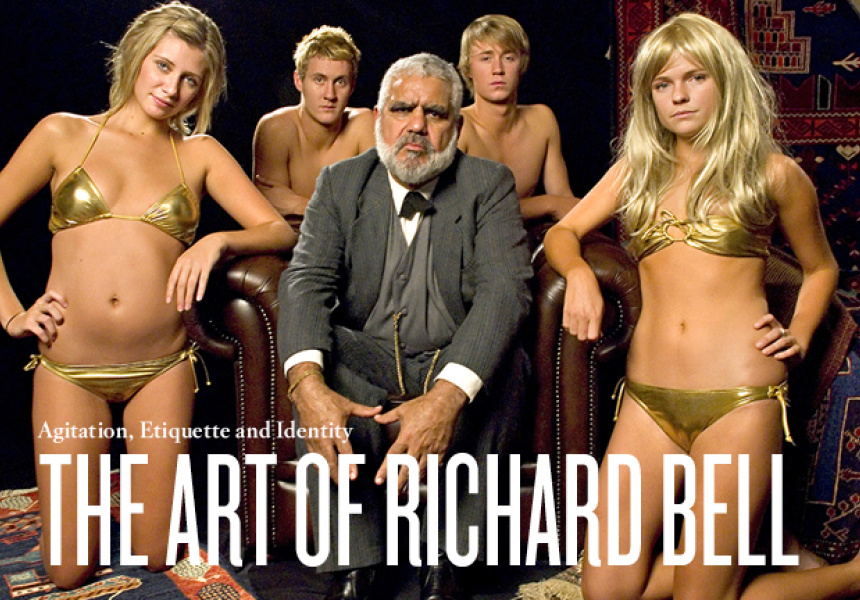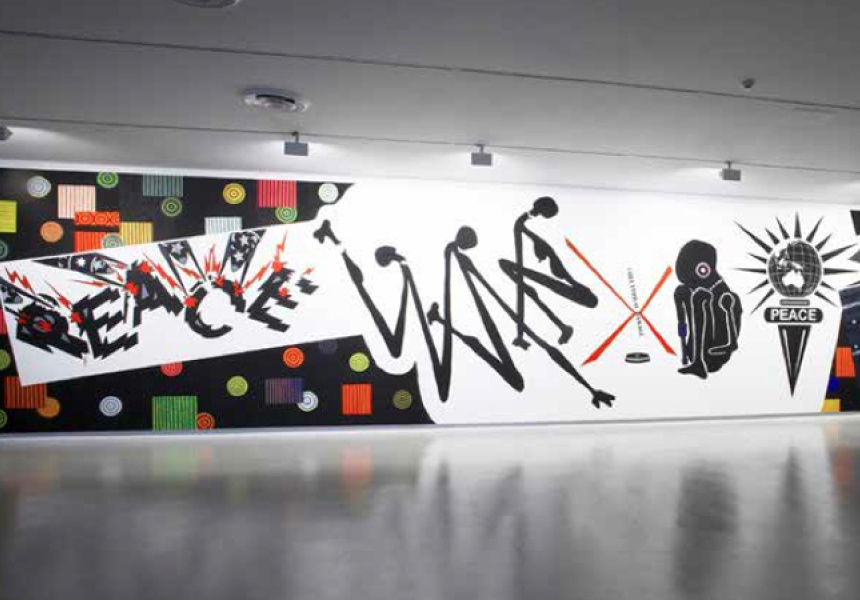It’s no mistake that in his essay, Decolonisation Now: The Activism of Richard Bell, Aboriginal journalist and broadcaster Daniel Browning describes the artist as a “megaphone”. In a career spanning more than three decades, the various incarnations of Bell’s practice have spoken with an unyielding force.
But Bell’s overt brand of activism, reverse appropriation and the wonderfully propagandistic tenor via which he expresses it, isn’t activism as we commonly recognise it. Indeed, it’s the fact that Bell – a member of the Kamilaroi, Kooma, Jiman and Gurang Gurang communities – has, for so long, managed to confront and negotiate a taxonomy of mainstream, white Australia’s most disturbing tenets and mythologies, only with humour and a lightness of touch, that makes his work so effective, affecting and downright unsettling. Bell disarms, charms and entertains, only to turn the mirror square on. We smile, chuckle, then wake in fright. It’s an idea that circulates and envelops Lessons on Etiquette and Manners, a major survey of Bell’s work now in its final week at the Monash University Museum of Art (MUMA). Bell’s paintings, collages, murals, installations and video works are at once a colourful seduction, a complex assemblage of politics and ideas, and a blunt instrument.
It begins with his paintings and collages from the early 1990s, which are an amalgam of palettes and tones one might associate with strains of traditional Aboriginal art. Again, it is a lure, a hook. On closer inspection, the shudders of ochres, earthy browns and yellows are defaced with the European motifs and symbology; percentage signs, currency symbols and the born-again Christian fish are carved and scraped into the surface; newspaper clippings, right-wing opinion pieces and found images consider the pervasiveness of entrenched racism. Out to dry (1993), meanwhile, maps out an “Aboriginal Degree in De-colonisation”.
Stay in the know with our free newsletter. The latest restaurants, must-see exhibitions, style trends, travel spots and more – curated by those who know.
SIGN UPThe suite of large-scale paintings from the Bell’s Theorem series from the 2000s comprise a patchwork of vividly colourful patterns and motifs, complete with incisive turns of phrase – “Australian art, it’s an Aboriginal thing” and “Aboriginal art, it’s a white thing” – emblazoned across their surfaces. It’s a little nugget of linguistic play, a currency that Bell negotiates so successfully.
In the vast space that follows, and opposite Bell’s striking mural made in collaboration with Emery Douglas, former minister for culture of the Black Panther Party in the US, Bell uses the appropriation of pop art (namely Roy Lichtenstein’s iconic comic book-style paintings) as a tool for artistic and political naming and shaming. It is an aesthetic about face, a hijacking of the oppressor’s culture’s visual language. One work lists a string of colonial era and more recent painters to have imposed themselves upon or appropriated a landscape that is, in essence, a stolen one. Another confronts the death in custody of Cameron Doomadgee and the aftermath on Palm Island.
There are more playful works; the cheeky T-shirts sporting slogans like “white girls can’t hump” and “it’s only the Art Gallery of NSW”. There’s also the disturbing and all too familiar video, Broken English (2009), which compiles street interviews with non-Aboriginal Australians, Aboriginal Australians and tourists, garnering people’s thoughts (or lack thereof) on Indigenous Australia and exploring notions of white mythology.
The centrepiece would have to be Scratch and Aussie (2008). Almost cinematic in scale, the video casts Bell as a therapist considering the trivial middle-class concerns, racist jokes and rants, and disquieting word associations that spill from his couch-reclining, blonde, gold swim-suited Anglo-Australian patients in one sequence, only to recast him as patient in another, unfurling his soul to stand-in therapist and long-time collaborator Gary Foley. It is here that Bell manages his greatest about-face and power shift. With a giggle and laugh, he expresses not the pain of everyday racist belittlement, but the abject absurdity of those who flaunt it. He laughs at his bikini-clad and budgie-smuggling subjects, not with them.
Richard Bell: Lessons on Etiquette and Manners runs until April 13 at MUMA.
MUMA
Ground floor, building F
Monash University Caulfield Campus
900 Dandenong Road
Caulfield East
Hours
Mon to Fri 10am–5pm
Sat noon–5pm



